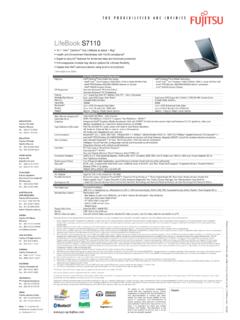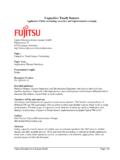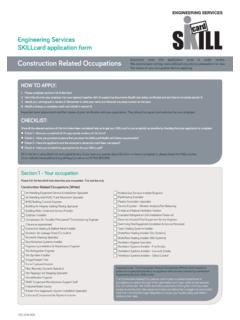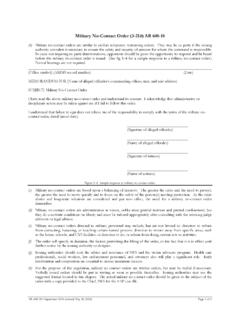Transcription of Clinical CAPA: Embedding Quality into Clinical Research
1 White CAPA: Embedding Quality intoClinical ResearchPublished Jointly By MasterControl Inc. and fujitsu LimitedWhite paperPage 2 of primary objective of any Clinical trial is to determine the clinicalsafety and efficacy of an investigational criticalcomponent of obtaining conclusive data is to conduct a high Quality in a Clinical trial must begin long before thefirst patient is enrolled and continue through the completion of theclinical study report (CSR).Management of Quality in Clinical consistsof multiple factors and tools working together to control and insurequality throughout the life of a trial. One such tool is the use of clinicalcorrective actions and preventative actions ( Clinical CAPA) when certaindeviations or Quality concerns there are no currentmandatory regulatory requirements for a company to implement aClinical CAPA process, managing Clinical Quality using corrective andpreventative actions is not new to InternationalConference for Harmonization (ICH) released guidelines for GoodClinical Practice (GCP)
2 As a scientific Quality standard for designing,conducting, recording and reporting trials that involve the participationof human guideline was developed with considerationof the current good Clinical practices of the European Union, Japan, andthe United States, as well as other countries and health much of the oversight of a Clinical trial falls on the shouldersof the Institutional Review Board (IRB), the sponsor or CRO isresponsible for insuring that all of the documentation and informationregarding the procedures of the Clinical trial are in most companies do not have a formal Clinical CAPA processthey do have Quality control and Quality assurance processesembedded into their Clinical management good clinicalquality plan does not rest solely on a CAPA process.
3 It requires qualityprocedures to be in place in order to identify necessary actions prior to,during and after a CAPA is , a complete qualityplan includes criteria for evaluating when a CAPA is or is not Cornerstones of Quality in Clinical ResearchThere are three independent areas of Quality that make up a completequality plan for any organization: Quality Assurance, Quality Control,and Risk Management. Although these three areas work closelytogether they should not be merged or mistaken for each other as theyprovide a checks-and-balances approach to managing Quality plan must start with defining the ideal desired level ofquality in all areas of the Clinical trial that idealthreshold, processes can then be established and put into place toensure that these standards are met and define who is responsible forexecuting and ensuring these Quality Actions (CA) and Quality Control (QC) Quality Controls are procedures put in place to insure that the resultsare as expected.
4 After executing procedures, and if inconsistencies arefound, actions can be taken to rectify the issues. Examples of qualitycontrol are monitoring visits, audits, documentation of findings andcorrective actions/preventative actions (CAPAs).Corrective actions can be taken without the need for a preventativeaction or formally filing a number of factors may impact thedecision to simply correct an action and take no further action; factorssuch as risk, impact, severity, and frequency of the immediate action must be taken to correct an issue that isidentified in order to continue with the example, a monitoris conducting a site interim monitoring visit and finds that aninvestigator has placed the investigational product on a window sill indirect light when product storage instructions state that the productshould be stored in a dry cool place or possibly inquires how long the product has been there and requeststhat it be placed in a proper storage corrective action inthis example is the proper placement of the product in order to rectifythe issue immediately.
5 A decision that must be made as to themagnitude of the this an isolated case of an investigator notfollowing directions? Is this occurring at other sites? Could it be thatproper instructions for product storage were not highlighted in theprotocol or training materials?These are the types of questions thatmust be considered when deciding if an issue or deviation should beescalated to a Action (PA) and Quality Assurance (QA) Quality Assurance consists of procedures and standards that outlinewhat must be done, when and by whom. This is used to insure thattasks are done correctly and consistently as many waysquality assurance plays the same role as preventative of Quality assurance are standard operating procedures(SOPs)
6 , protocols, and training Actions are actions taken to reduce risk and preventative actions can be made before anissue occurs or in response to a finding or , however, oftendrives the decision of whether or not to take a preventative action afteran issue has been a compliance issue is found to beinfrequent or evaluated as minimal risk, a decision can be made tosimply correct the immediate issue, document it for record-keepingpurposes, but not take further action to prevent it from the example given earlier, an investigator is found to be improperlystoring investigational product; if the monitor finds that a trend isoccurring and that a number of various sites are found to be improperlystoring the product, a preventative action may be taken to amendtraining materials or the protocol to include an emphasis on storageand retrain study staff across all so would make theimmediate correction of the issue the corrective action (CA) and theamending of training materials and request for retraining as thepreventative action (PA).
7 If the monitor finds that the improperstorage of the product is an isolated case or occurs infrequently, thenimmediate corrective action to close out the issue and document thataction may the example stated the risk of not storing theproduct properly could have negatively impacted the product, makingit unsafe or ineffective and could compromise the findings of the ManagementRisk management is the task of identifying, measuring, andprioritizing the impact of the uncertainty of various variablesthroughout a Clinical trial. For example, a protocol that containscomplex tests and procedures has a higher risk of noncompliance thanone that contains basic testing and exam complexitymay increase likelihood of errors as well as delays in the event that afacility requires a third-party lab to conduct some of the can further be minimized through extensive screening andselection process of Clinical sites to participate in a Clinical are a number of ways a study owner can reduce risk at theclinical site level both before selecting a site as well as during theclinical few examples are listed in Table paperPage 3 of 1 Risk Areas for Clinical Site SelectionRisk AreaBenefitInvestigatorQualificationExpe rtise and
8 Experience can lead toincreased Quality of results and earlydetection of complications should QualificationSelecting a site with proper facilities andequipment ( , lab, pharmacy, CT Scan),can increase visibility, accountability as wellas reduce Audit HistoryPast experience with a site and thefrequency of issues and audit results shouldbe a factor in prioritizing the use of a sitesince past history is a good indicator offuture Staff TrainingProperly trained staff can significantlyreduce errors in data and in execution InformationLocationEasy access to essential study documentsfor reference as needed can increase qualityand compliance as well as reduce likelihoodof assumptions being strong risk management plan should include being able to predictissues before they occur.
9 However, this is often easier said than this end, it is important that Quality assurance procedures becustomized to each individual study s nuances and unique example, a study that requires a specific demographic of studyparticipants that is narrow in scope should require a particular focus onthis area during site monitoring visits and when the sites are in this area can result in numerous patients being enrolled inthe study that should not have been and put both the patients and theoverall study at Quality of Clinical Research results can be significantly impacted bylack of training, inadequate facilities, incomplete data entry, misseddoses and test, improper patient enrollment, and so much of the individuals monitoring and auditing the study activities arecritical to managing risk and proactively putting processes and checksin place to reduce risk of noncompliance.
10 One way to do this is toclearly define roles and responsibilities of the sponsor, the clinicalresearch organization (CRO), and the and Responsibilities of QualityCommunication and clearly defined ownership of responsibility play asignificant role in managing Quality and risk in a Clinical a sponsor is managing a Clinical trial or outsourcing some orall Clinical management tasks to a CRO, defining responsible parties fordifferent aspects of the Clinical trial is something that should becommunicated thoroughly to all study delegation ofresponsibility and roles can be further assisted though the use ofprocess oriented applications that distribute tasks to the appropriateparties as processes progress throughout the life of a toolsalso provide the ability to quickly track and trend different aspect of atrial to measure failure or success and manage Clinical trial ismade up of various responsibilities such as training, site qualification,site initiation, monitoring visits, patient enrollment, adverse eventreporting.














